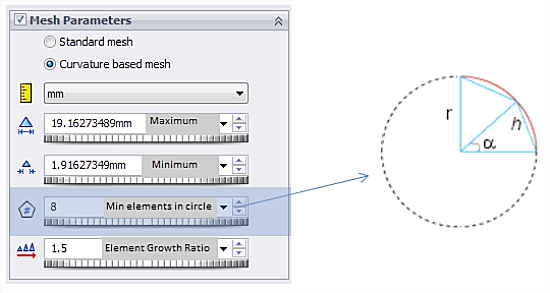
SolidWorks Simulation and the Art of Meshing
By Hawk Ridge Systems Engineering Team
CAD/CAM/CAE CAD FEA analysis Hawk Ridge Systems simulation SolidWorksWhen to choose Curvature-based vs Standard meshes plus the Art of Meshing webinar.
Do you typically use the Standard mesh or the Curvature based mesh when preparing to run a study in SolidWorks Simulation? I’m often asked what the difference is between the two and why I prefer the Curvature based method. While the topic of discretizing or meshing can get highly technical and easily cover several whitepapers, I’ll highlight a couple of main points in this article.
Let’s begin our discussion with the Standard mesh. The Standard mesh lets us specify a Global Element Size and a Tolerance value. It makes use of Voronoi-Delaunay triangulation, which tries to maximize the smallest angle of all triangles, while the geometry is being split into element triangles or tetrahedrons. In essence, the Standard mesh tends to avoid skinny triangles and hence helps reduce the number of elements with a high aspect ratio, which can affect the accuracy of our results. The Standard mesh does a great job of creating a uniform and reliable mesh.
During the Standard meshing process, faces are meshed first. The software attempts to fill each face with equilateral triangles with the size equal to the specified element size. Edges of the faces are maintained while the specified tolerance value is used to knit the surface meshes into a solid. Once the faces are meshed and knit, the volume is filled with tetrahedrons. During the volume filling phase, the Standard mesh is able to take advantage of multi-core processors to help minimize the time required to mesh the geometry.
The Curvature based mesh on the other hand, supports both multi-core surface and volume meshing. Hence many tend to favor the Curvature based mesh for a complex part or assembly analysis as it generally performs better than the Standard mesh, by taking greater advantage of multi core processors.
With a Curvature based mesh, the element size is determined mathematically by the minimum number of elements that fit in a hypothetical circle, while taking into account the user specified minimum and maximum element size. In the figure below, the default value of 8 for the minimum number of elements in a circle is used, so the red arc would contain 2 elements. If we increased the value to 16, the red arc would contain 4 elements, as long as the h value is between our specified min/max element sizes.
The ability to define both minimum and maximum element sizes allow for a more robust mesh that “adapts” to the geometry by using smaller elements where the curvature is highest. Therefore, when meshing complex geometry or assemblies with a large variance in part sizes, this mesh type typically requires much less effort and fewer mesh controls are needed for the mesh to be successful. Meshing multi-body parts or assemblies using an incompatible mesh is one particular scenario where a Curvature based mesh truly excels. Using an incompatible mesh increases the success rate of both the Standard and Curvature based methods, as the mesh isn’t forced to merge nodes between bodies. One item to note about the Standard mesh is that it allows engineers to apply mesh control on vertices, while a Curvature based mesh ignores mesh control applied on vertices.
While there is no right or wrong choice between the Standard and Curvature based methods, I’ve found myself leaning more towards a Curvature based mesh due to the higher rate of success and efficiency. Comparing the time required to mesh approximately 500,000 elements in a simple body, the Curvature based mesh is more than twice as fast as the Standard mesh. For this example it took 21 seconds using a Curvature based mesh versus 49 seconds using a Standard mesh.
Whichever mesh type you choose, it is important to keep element aspect ratios in mind and review your Mesh Quality plots. A general rule of thumb from the Simulation Training manual is to keep the aspect ratio below 50 in areas where stress is of crucial importance. Although the Standard mesh typically does a better job of avoiding high aspect ratio elements, my experience has shown the Curvature based mesh does a great job of avoiding aspect ratio issues as well. Note the Maximum Aspect Ratio from the example above, the Curvature based mesh has a lower value compared to the Standard mesh.
For a more in depth discussion on meshing, be sure to check out Hawk Ridge Systems’ webinar, The Art of Meshing, or check out other SolidWorks tips and tricks on the Hawk Ridge Blog.
www.hawkridgesys.com




